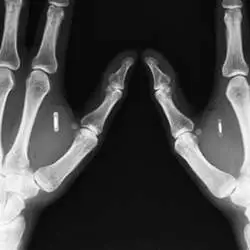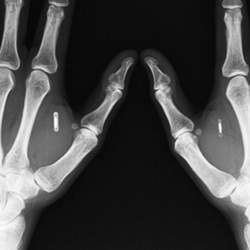
Tim Shank is as plainspoken as one might expect a software engineer to be. A Minneapolis-based engineer for a large portrait photography company, Shank takes seriously the idea of evaluating the place of the “quantified self” in the networked world.
Shank has gained a bit of notoriety as a pioneer of the “biohacking” movement, in which practitioners are implanting small chips into their bodies and hacking ways to use those chips to perform actions such as opening door locks, booting up computers, and sharing contact information with nearby mobile devices.
Though much of the media attention Shank and his biohacking peers have attracted has been a mix of the “gee whiz” and “eewwwww!” varieties, he said he merely wanted to be among the first to dispassionately evaluate how the technology works in one who has literally inserted oneself into the digital network.
“Broadly speaking, this is the way technology is going,” Shank said. “It’s getting smaller and smaller and closer and closer and I am 100% confident it will be internalized some time in the next 20 years; it will be fairly common to have your technology inside yourself. You won’t have to pick up a device or wear something to be connected. I’m taking the first steps so I can understand the technology, the complications, and the impact of it before it gets into the mass market, where there is less real technological information available involved in making the decision.”
Shank had three small chips (one RFID chip and two near-field communications (NFC) chips) and one small magnet implanted in his hands by a local piercing artist, and has demonstrated their utility in tasks such as unlocking doors.
He is currently working on the prototype of a social benefit application for his implanted magnet; the magnet interacts with sensors placed at strategic points in a room in order to help the sight-impaired navigate. That application fits into what may be the most interesting aspect of watching these “quantified self” technologies roll out: the convergence of the things the hobbyist community is doing with implantable technology and what academic, commercial, and government research projects are doing to address serious clinical conditions.
“Even though there is no obvious crossover at the moment, you know the trajectories are headed toward each other,” Seattle, WA-based biohacking pioneer Amal Graafstra said. Graafstra’s interest in implantable technologies led him to found a business whimsically called Dangerous Things, which supplies chips and injector kits to biohackers and is building a global network of professional implanting artists.
Implanting Convenience
The most visible applications of implantable technologies in the near term will be those of convenience. Shank, for instance, uses his glass-encapsulated chips, which he said are approximately the size of two grains of rice, to gain access to two of his computers, which he does with the RFID chip, and his home, for which he uses his NFC chips.
“I am going to put another reader in my car,” Shank said. “I hope to eliminate the use of keys altogether.”
Shank found enough people with interest in biohacking in the Minneapolis-St. Paul area that he founded a Meetup group, TwinCities+; the scope of the group has expanded from what he called an opportunity “just to geek out” to carefully considering the implications of all sorts of emerging platforms, including not only implantables, but also artificial intelligence and virtual reality platforms.
“You talk to people, even people in tech, and their eyes kind of glaze over. They don’t want to give any thought to how these things will affect them five years down the line,” he said.
Graafstra is placing a big bet on wider utilization of implants. Dangerous Things is introducing an implantable full cryptographic identity platform called UKI in January. It has the ability to run cryptography, security, and identity applications, a bitcoin wallet, mass-transit account balances and transactions, and possible payment compatibility “if we can get some banks on board,” Graafstra said. The Java Card-based platform will be programmable through the user’s smartphone.
Another approach to putting the network in—or, in this case, on—the body was introduced in August, when researchers at the Massachusetts Institute of Technology Media Lab and Microsoft Research unveiled the DuoSkin, a user-designed gold leaf tattoo that combines the aesthetics of body decoration with input, output, and NFC-based communications capabilities. While Shank and Graafstra both recognize DuoSkin will likely appeal to a wider audience than implants for convenience applications, neither is interested in adopting it personally.
The DuoSkin, a gold leaf ‘tattoo’ that combines the aesthetics of body decoration
with input, output, and NFC-based communications capabilities.
Credit: MIT Media Lab, Microsoft Research
“The temporary tattoos look interesting,” Shank said. “In fact, some friends and I are going to try to replicate the process for those DuoSkin tattoos. For myself, I don’t want these shiny things. I’d rather just be me and just have this little edge of where I’m connected. I think the tattoo is the path to mass adoption, but I’m not stopping there unless there’s additional functionality I’m not already getting.”
“It’s not permanent and doesn’t really solve the problem of managementlessness,” Graafstra said. “If implants are done well and designed well, they are managementless.”
Convenience, Clinical Uses Set To Converge
Graafstra foresees circuit-equipped tattoos being especially useful for medical data-gathering during a discrete time period. Despite the hype about wearable fitness trackers, time-crunched clinicians simply are not equipped to collect and analyze the minutiae of everyday activities of entire patient panels on an ongoing basis. However, periodic check-ins of functions such as heart rate, blood pressure, or blood glucose level could be greatly enhanced through transcutaneous sensors, said Dr. Peter B. Weber, chief neurosurgeon at California Pacific Medical Center.
“Start to combine those factors and you may prevent a lot of ER visits and admissions, because you can predict who is heading in the wrong direction, and it’s worth a phone call from a nurse,” Weber said.
Weber, one of the first surgeons to employ an implant-based neuro-stimulation system to reduce the number and severity of epileptic seizures, said the continued miniaturization of clinically validated technologies is an “inevitability,” citing the Moore’s Law principle. He also said as such technologies were introduced in clinical trials and research studies conducted under recognized protocols, they were likely to gain legitimacy among the scientific community, as well as the public at large.
The U.S. Defense Advanced Research Projects Agency (DARPA) is an active testbed of implantable technology for therapeutic use. Two current projects, Revolutionizing Prosthetics, and Systems-Based Neurotechnology for Emerging Therapies (SUBNETS), are exploring the use of closed-loop interfaces with brain implants. Justin Sanchez, director of DARPA’s Biological Technologies Office, said the projects demonstrate the importance of adhering to scientific rigor and iterative design. For instance, one advanced version of the prosthetics technology uses foot-worn inertial measurement units to control a prosthetic arm; the brain-sensor controlled version is still under development, and is a hard-wired design. However, Sanchez said, the project’s advances have fed into the work on SUBNETS.
“Once we realized we wanted to work in another domain of brain function, neuropsychiatric illness, that enabled us to take the next step and challenge the (scientific) community to miniaturize the system we want to interface with the brain, and to see if the community can create wireless interfaces to the brain.”
While Sanchez was careful to point out that biohacking door locks and designing miniaturized feedback circuits to the brain are very different applications, he also said wider adoption of implantable technologies can help democratize—some might say also normalize—the connected self.
“These early adopters, even just playing around with these technologies, help to frame the conversation for the different sides of where that technology may emerge. In the bigger picture of things, those communities are part of the equation of how the technologies ultimately mature over time.”
Gregory Goth is an Oakville, CT-based writer who specializes in science and technology.





Join the Discussion (0)
Become a Member or Sign In to Post a Comment